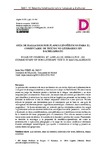Guía de hallazgos por planos lingüísticos para el comentario de textos no literarios en Bachillerato

View/
Use this link to cite
http://hdl.handle.net/2183/30302
Except where otherwise noted, this item's license is described as Atribución-CompartirIgual 4.0 Internacional (CC BY-SA 4.0)
Collections
Metadata
Show full item recordTitle
Guía de hallazgos por planos lingüísticos para el comentario de textos no literarios en BachilleratoAlternative Title(s)
Guide of Findings by Linguistic Ambits for the Commentary of Non-literary Texts in BaccalaureateAuthor(s)
Date
2021-12-29Citation
Pérez Alonso, J. E. (2021). Guía de hallazgos por planos lingüísticos para el comentario de textos no literarios en Bachillerato. DIGILEC: Revista Internacional de Lenguas y Culturas, 8, 151-163. https://doi.org/10.17979/digilec.2021.8.0.8597
Abstract
[Resumen] La práctica del comentario de texto no literario es uno de los objetivos fundamentales en la asignatura de lengua castellana y literatura en la etapa de Bachillerato. En esta tarea se ponen en juego los distintos planos o ámbitos de la lengua vinculándolos a un texto propuesto para el comentario. Pese a ello, los estudiantes encuentran grandes dificultades para identificar y estructurar las características lingüísticas presentes en los textos y los docentes se enfrentan al reto de ofrecer respuestas didácticas a este ejercicio. En este artículo se propone una herramienta para el comentario que se basa en una guía de hallazgos en los distintos planos lingüísticos (morfológico, sintáctico, léxico-semántico y pragmático). De forma secuenciada, se pretende que los estudiantes analicen los rasgos lingüísticos en cada uno de estos ámbitos en una triple dimensión (presencia, localización y finalidad), es decir, identificándolas, ejemplificándolos y justificando su uso en función de la intención del texto propuesto para el comentario. Para ello es necesario realizar varias tareas antes de afrontar el comentario y durante la práctica del mismo. Finalmente, se describe la estrategia y la propuesta de enseñanza-aprendizaje, así como su secuenciación y aplicación pedagógica a lo largo de un curso académico utilizando diversas estrategias metodológicas que ayudan a sistematizar el trabajo y ponerlo en común dentro del grupo-aula. [Abstract] The non-literary text commentary is one of the fundamental objectives in the contents of Spanish Language and Literature subject at the Baccalaureate stage. In this task, the different levels or domains of language come into play linking them to a text proposed for commentary. In spite of this, students find great difficulties to identify and structure the linguistic characteristics present in the texts and teachers face the challenge of offering didactic answers to this kind of exercise. In this article a tool for the commentary is proposed that is based on a guideline of findings in the different linguistic ambits (morphological, syntactic, lexical-semantic and pragmatic). Gradually, it is intended that students analyze the linguistic features in each of these areas in a triple dimension (presence, location and purpose), identify, exemplify and justify their use depending on the text target. For this purpose, it is necessary to carry out several tasks before facing the commentary and during its practice. Finally, the teaching-learning strategy and proposal is described, as well as its sequencing and pedagogical application throughout an academic year using various methodological strategies that help to systematize the work and share it within the classroom group.
Keywords
Guía práctica
Texto no literario
Comentario de texto
Didáctica
Lengua castellana
Practical guide
Non-literary text
Text commentary
Teaching
Spanish
Texto no literario
Comentario de texto
Didáctica
Lengua castellana
Practical guide
Non-literary text
Text commentary
Teaching
Spanish
Editor version
Rights
Atribución-CompartirIgual 4.0 Internacional (CC BY-SA 4.0)
ISSN
2386-6691






